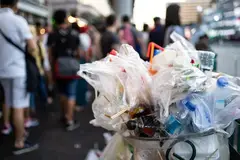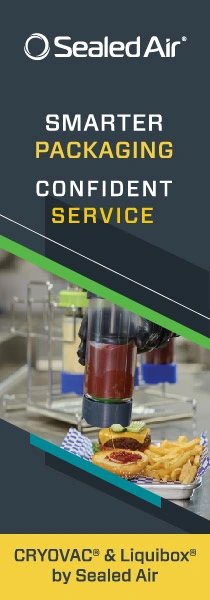HolyGrail 2.0: Digital watermark experts explore mechanical recycling’s untapped potential
The Digital Watermarks Initiative HolyGrail 2.0 has conducted new waste sorting trials and has found that sorting volumes were “remarkable,” highlighting the efficiency of digital watermarking technology for packaging waste management.
Digital watermarks (DW) are postage stamp-sized codes that can be printed on packaging and carry information like material type. DW can be detected by high-resolution cameras on sorting lines, enabling extremely accurate sorting and increased recycling rates.
DW’s biggest advantage over alternatives, such as Object Recognition (OR), is their proven effectiveness for flexible plastic packaging, and the additional use cases they provide beyond advanced sorting, Martyn Tickner, chief advisor of Circular Solutions at The Alliance to End Plastic Waste, tells Packaging Insights.
HolyGrail 2.0 is driven by AIM, the European Brands Association, and powered by the Alliance to End Plastic Waste.
We sat down with Tickner and Margherita Trombetti, sustainability project manager and policy officer at the AIM, to discuss the initiative’s latest trial findings and how the technology helps meet regulatory recycling targets.
What can you tell us about HolyGrail 2.0 and its successes so far?
Tickner: Once packaging arrives at a waste sorting facility, DW can be detected and decoded by a high-resolution camera on the sorting line. The information encoded within the DW allows for the sorting of the packaging into its corresponding waste streams, resulting in better and more accurate sorting and consequently, higher-quality recyclates.
In 2023, industrial trials at a recycling plant in France demonstrated the effectiveness of DW in separating food and non-food PET trays in waste streams, a critical step toward meeting European Food Safety Authority guidelines. This was followed by trials in Germany that proved the ability of the technology to successfully sort food-grade PP flexibles and hygiene-grade PE flexibles at efficiency rates not possible with other technologies. The technology enables even more challenging sorting, for example of mixed material structures, by a polymer’s mechanical properties (rheology), intended use, type of additives, inks, and adhesives.  Martyn Tickner, chief advisor of Circular Solutions at The Alliance to End Plastic Waste.
Martyn Tickner, chief advisor of Circular Solutions at The Alliance to End Plastic Waste.
What is the significance of the initiative’s latest breakthrough?
Tickner: Assessing the efficiency of DW applied to rigid household packaging in Germany and Denmark, the latest HolyGrail 2.0 trials conducted at the Hündgen Entsorgung material recovery facility in Swisttal, Germany, had positive results. The sorted material volumes saw detection rates reaching an average of nearly 56,000 detections per day, totalling 5.66 million detections of 5,949 unique SKUs over a 100-day period. Detection efficiency ranged from 87.9% to 93.8%, consistently exceeding 90% through rigorous cloud-based analysis.
The trial confirms the capability of DW for accurately sorting post-consumer rigid household packaging, achieving 90% — or higher — sorting efficiency even under challenging real-world conditions and single-pass sorting.
Mechanical recycling has untapped potential to produce high-quality recyclates, but this can only happen if feedstocks are subjected to more discerning sorting. For example, sorting by polymer type and color is not sufficient. We need to be able to select or reject materials for a particular recycling stream based on the composition of different polymers, intended use, the presence of inks, adhesives and additives, and the mechanical properties (rheology) of a polymer. This requires the positive identification of the particular article or packaging and the ability to look up specific attributes in a database such as Global Standard One (GS1), which issues barcodes as a unique Global Trade Item Number.
What are DW’s advantages for recycling compared to other methods?
Tickner: Near-infrared (NIR) spectroscopy is already commonly used to detect different polymer types, and the boundaries of NIR are constantly being extended to new use cases. AI-enabled OR also holds great promise and can support database lookup, with the potential to fulfill many of the requirements needed for advanced sorting.
However, OR and NIR still have some margin for error as compared to DW, which are definitive when it comes to identifying packaging. Given this, DW will be preferred for specific use cases, such as replacing QR codes and barcodes at the retail check-out, which, combined with identification when received back in a waste stream, also enables big data on recycling rates by article type. At the same time, while both OR and DW can work well with rigid packaging, OR will struggle with flexible packaging due to shape variability or multi-layered packaging.
How does DW enhance regulatory compliance?
Tickner: To meet the regulatory targets of the EU’s Packaging and Packaging Waste Regulation (PPWR), progress on sorting infrastructure and an upgrade in recycling capabilities is needed. It will take many years to install adequate infrastructure for solutions such as chemical recycling. However, we already have significant mechanical recycling capabilities in place, which can be more rapidly developed to meet PPWR targets as long as feedstocks are accurately sorted. Margherita Trombetti, sustainability project manager and policy officer at the AIM.
Margherita Trombetti, sustainability project manager and policy officer at the AIM.
The industry should focus on implementing advanced sorting, with a view to potentially managing this on a large scale as a second sorting step, for example as Svensk Plaståtervinning is doing at Site Zero in Sweden.
It is important to note that meeting the 2030 targets the PPWR requires investment not only in sorting but also in recycling capabilities. Without this, DW, OR, or any other technical development by themselves cannot pave the way to PPWR compliance. Hence, it is important we move forward with the existing technologies already in place today that will support the viability of downstream investments, rather than waiting for newer technologies such as OR to meet the need. This approach would offer a faster route toward PPWR compliance.
Trombetti: DW embody the perfect example of how the EU-wide goal of the green and digital transitions can happen together: DW carry a wide range of attributes (for example, manufacturer, SKU, type of plastics used, composition for multi-layer objects, food vs non-food application), with the potential to enable the creation of a Digital Packaging Passport that can help companies meet EU reporting requirements, such as communicating the material composition of the packaging to facilitate sorting, the presence of substances of concern, or even getting precious data for their EPR reporting obligations.
What are the challenges for packaging companies adopting DW at scale?
Tickner: While DW technology has been fully demonstrated, companies are often not entirely convinced that adoption will lead to positive business benefits and regulatory compliance. In addition, there is only one fully demonstrated, mature DW technology provider on the market today, leading to concerns that the technology will become a “walled garden.”
However, there are also other DW technologies and other detection alternatives such as OR that are maturing quickly and offer competitive alternatives in case that concern becomes a real issue. It is, therefore, important that we move forward with the technology that we already have today rather than waiting for alternative solutions that may only emerge in a few years’ time.
That is the nature of disruptive technology: once in the market, it will evolve and improve, and we will find use cases that have previously never been considered. However, this requires brands to be early adopters, investing in and developing these technologies.DW’s biggest advantage over alternatives is their proven effectiveness for flexible plastic packaging.
Trombetti: The business case of the DW technology still needs to be proven, and this is exactly the objective of the next initiative stage that has just been launched: HolyGrail 2030 — Circular Packaging. Another aspect is the competition from other state-of-the-art technologies that can also be used for sorting, namely AI/OR, which are also developing at quite a pace. This does not mean that one technology would prevail over the other in the (hopefully near) future, but on the contrary, the hope is that a multitude of technologies should be made available to the industry, ensuring flexibility to the users as well as a fair and competitive ecosystem.
It is worth noting that, in fact, all successful trial validations within HolyGrail 2.0 always relied on a combination of the current sorting technology, NIR, and DW. Last but not least, businesses are facing an uncertain political environment that does seem to be revisiting various sustainability objectives, thus creating uncertainty, which in turn impacts investment decisions.
How can HolyGrail 2.0 help overcome these challenges?
Tickner: HolyGrail 2.0 has demonstrated the efficacy of digital watermarking technology and is now evolving into the next phase, HolyGrail 2030. This next phase will concentrate on establishing market adoption, demonstrating the business benefits, and ensuring that sorting companies and recyclers can invest in detection technology with greater confidence of a return on their investment.
Trombetti: Just like in HolyGrail 2.0, the fact that the industry comes together in a consortium — HolyGrail 2030 — can help maximize learnings, as members bring different expertise, while reducing individual stakeholder’s efforts.
Can you elaborate on how you plan to expand the initiative?
Tickner: HolyGrail 2030 will begin with market implementation for flexible plastics in Belgium and rigid plastics in Germany and Denmark. We expect the scope of those initiatives to rapidly expand as other brands and retailers come on board, both within the early adopter markets and subsequently in other regions. To drive this expansion, support from Producer Responsibility Organisations (PRO) under EPR legislation is important, particularly as establishing improved sorting alongside adoption of improved packaging design is one of the most rapid ways to achieve PPWR compliance.
Trombetti: HolyGrail 2030 Consortium has just launched the Belgian market demonstration initiative, with the objective of unlocking the circularity of the PP flexible stream in Belgium via a demonstrated business case. Whilst the sorting technology will still be DW — as currently the most technically advanced for sorting — the idea is to also look at different recycling technologies to assess the output quality of the fractions sorted via DW — with a view to estimating material value and ROI for each value chain stakeholder. The Consortium is about to launch a similar initiative, this time focusing on rigid PP packaging in the German market. Potential expansion of the use cases and/or markets will be evaluated as soon as initial results and further funding become available.
Tickner: Today, the decision to start the recycling process with DW is a strategic decision. But once solutions are introduced to the market, industry will rapidly adopt these and evolve, and the technology with the best value-proposition will progressively dominate — until replaced by something better. At the end of the day, we need to make a start somewhere, otherwise there can be no progress.











